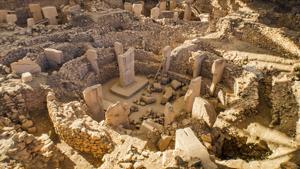
Göbekli Tepe in southeastern Turkey is widely regarded as the oldest known religious site in the world, dating to approximately 9600–8200 BCE during the Pre-Pottery Neolithic period[1][3][6]. This monumental complex, built by hunter-gatherers over 1,400 years, predates Stonehenge by 6,000 years and challenges traditional theories about the origins of settled societies[1][3][6].
Key Features
Architecture:
- T-shaped limestone pillars (up to 5.5 meters tall) arranged in circular enclosures, with central pillar pairs often weighing 10–20 tons[1][4].
- Walls constructed from unworked stone, forming 20+ enclosures across 8 hectares[1][6].
- Intricate animal reliefs (foxes, snakes, boars, birds) and abstract symbols carved into pillars[4][5].
Purpose and Significance:
- Initially interpreted as a ritual sanctuary due to the absence of permanent housing or agricultural evidence[3][6]. Recent excavations revealed domestic structures, wild cereal processing, and water systems, suggesting a semi-sedentary population[1][3].
- May have served as a pilgrimage site for regional hunter-gatherer groups, with evidence of feasting on wild animals (aurochs, gazelles)[3][6].
- Challenges the “Neolithic Revolution” theory by demonstrating large-scale cooperation and symbolic thought predating agriculture[1][3].
Discovery and Research
- First documented in 1963 but misinterpreted as a medieval cemetery[2][6].
- Archaeologist Klaus Schmidt recognized its Neolithic origins in 1994 and led excavations until his death in 2014[1][3].
- Geophysical surveys indicate less than 5% of the site has been excavated[1]. Recent finds (2023) include a painted boar statue with red, white, and black pigments—the oldest known painted sculpture[5].
Comparative Context
While Malta’s Ġgantija Temples (c. 3600 BCE) and Ħal-Saflieni Hypogeum (c. 3300 BCE) are among the oldest freestanding religious structures, Göbekli Tepe predates them by over 5,000 years[2]. Nearby Karahan Tepe (9400 BCE) shares similar iconography and winter solstice alignments, suggesting a regional ritual network[5].
Göbekli Tepe’s deliberate burial around 8000 BCE preserved its structures, earning it UNESCO World Heritage status in 2018[1][6]. Ongoing excavations continue to redefine our understanding of early human societal development.
Citations:
[1] https://en.wikipedia.org/wiki/G%C3%B6bekli_Tepe
[2] https://www.oldest.org/structures/temples/
[3] https://study.com/learn/lesson/gobekli-tepe-facts-discovery-location.html
[4] https://www.encounterstravel.com/blog/gobekli-tepe
[5] https://archaeologymag.com/2023/10/statues-found-in-gobekli-tepe-and-karahan-tepe/
[6] https://www.archdaily.com/900795/the-worlds-oldest-piece-of-architecture-tells-a-new-story-about-how-civilization-developed
[7] https://www.perplexity.ai/page/the-world-s-oldest-religious-s-3RaL0tS_SeeozvqNlb_MnQ
[8] https://www.architecturaldigest.com/gallery/oldest-temples
[9] https://en.wikipedia.org/wiki/List_of_oldest_church_buildings
[10] https://www.nationalgeographic.com/magazine/article/gobeki-tepe
[11] https://www.youngpioneertours.com/gobekli-tepe/
[12] https://www.smithsonianmag.com/history/gobekli-tepe-the-worlds-first-temple-83613665/
[13] https://philarchive.org/rec/ZALWDG
[14] https://www.dainst.blog/the-tepe-telegrams/2023/01/16/over-twenty-five-years-of-research-at-gobekli-tepe/
[15] https://www.templeton.org/news/gobekli-tepe
[16] https://www.archaeology.wiki/blog/2023/10/04/new-findings-have-come-to-light-in-gobeklitepe-and-karahantepe/
[17] https://www.linkedin.com/pulse/gobekli-tepe-role-gathering-ritual-evolution-humans-anthony-3macc
[18] https://www.worldhistory.org/G%C3%B6bekli_Tepe/
[19] https://artdogistanbul.com/en/new-findings-in-gobeklitepe-and-karahantepe-the-first-painted-neolithic-statue/
[20] https://www.tandfonline.com/doi/full/10.1080/1751696X.2024.2373876
[21] https://www.britannica.com/place/Gobekli-Tepe
[22] https://www.linkedin.com/pulse/g%C3%B6bekli-tepe-ancient-temple-redefined-human-history-ryan-kang-i9tye
[23] https://www.reddit.com/r/AskHistorians/comments/1ansae/what_is_the_significance_of_gobekli_tepe/
[24] https://www.metafilter.com/201983/Architectural-design-at-Gbekli-Tepe
[25] https://study.com/learn/lesson/gobekli-tepe-facts-discovery-location.html
[26] https://www.thearchaeologist.org/blog/new-great-discoveries-in-gbeklitepe-the-first-painted-statue-and-one-of-the-most-lifelike-human-sculpture-ever-found
[27] https://www.cambridge.org/core/journals/cambridge-archaeological-journal/article/geometry-and-architectural-planning-at-gobekli-tepe-turkey/2CBAF416E33AFE6496B73710A2F42FF9
[28] https://www.dailysabah.com/life/history/gobeklitepes-latest-mystery-reveals-stone-tool-technology
[29] https://www.researchgate.net/publication/338583959_Geometry_and_Architectural_Planning_at_Gobekli_Tepe_Turkey
[30] https://www.heritagedaily.com/2020/05/gobekli-tepes-construction-11500-years-ago-was-guided-by-geometry/129063
[31] https://artsandculture.google.com/story/g%C3%B6bekli-tepe/OALyoXJ7tDcpLA
[32] https://perapalace.com/en/8-things-to-know-about-gobeklitepe/
[33] https://en.wikipedia.org/wiki/History_of_religion
[34] https://www.worldatlas.com/articles/oldest-places-of-worship-still-standing.html
[35] https://www.historyofinformation.com/detail.php?entryid=3307
[36] https://popular-archaeology.com/article/gobekli-tepe-discovering-the-worlds-oldest-religious-site/
[37] https://www.civitatis.com/blog/en/oldest-temples-in-the-world/
[38] https://popular-archaeology.com/article/echo-from-the-past-how-gobekli-tepe-is-reshaping-our-understanding-of-the-neolithic-2/
[39] https://karlobag.eu/en/history/the-discovery-of-turkeys-oldest-temple-gobekli-tepe-raises-new-questions-about-prehistoric-religion-and-social-development-qdm73
[40] https://en.wikipedia.org/wiki/G%C3%B6bekli_Tepe
[41] https://archaeology.org/issues/january-february-2018/collection/turkey-neolithic-skull-cult/top-10-discoveries-of-2017/
[42] https://dergipark.org.tr/en/download/article-file/2711251
[43] https://whc.unesco.org/en/list/1572/
[44] https://www.sci.news/archaeology/gobekli-tepe-geometry-08424.html
[45] https://arkeonews.net/new-discoveries-in-gobeklitepe-and-karahantepe-a-human-sculpture-with-a-realistic-facial-expression-found-in-karahantepe/



